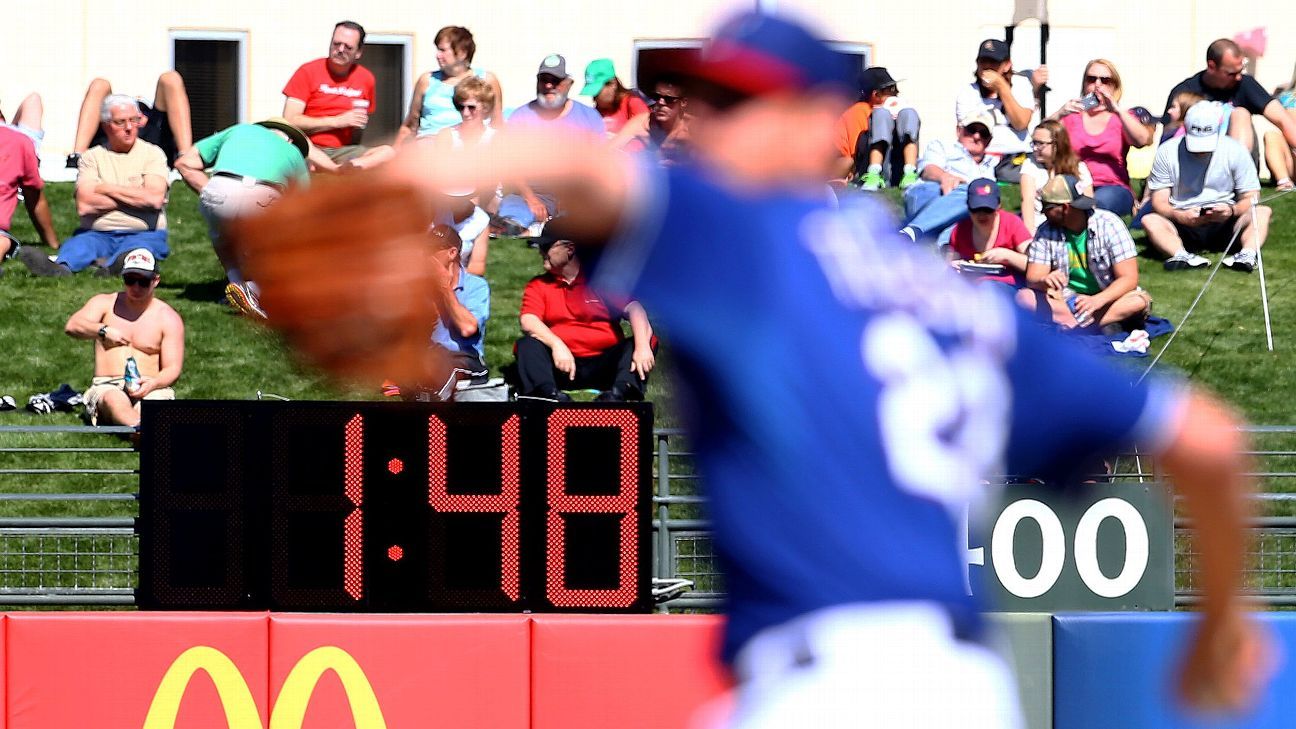What you need to know about MLB’s 2023 rule changes

Change is coming to the major leagues! Last September, Major League Baseball’s competition committee
The 2023 fantasy baseball season is here! Get the gang back together, or start a brand new tradition.
Join or start a league for free >>
Each stadium will have two clocks located behind home plate on either side of the umpire while two more will be required in the outfield on either side of the batter’s eye. Spring stadiums may only have one clock in the outfield but will otherwise be fitted to the exact parameters as the MLB ones. Each umpire will be equipped with technology which will inform them when the pitch clock has expired. And for the first time, umpires will also have the ability to speak with each other via communication devices without having to meet in the middle of the infield.
What they’re trying to change: The average time of a nine-inning major league game in 2022 was 3 hours, 4 minutes, which is actually a six-minute decline from 2021’s all-time high — but the time of game has been rising consistently since first crossing the three-hour mark in 2014.
While it is not directly correlated, Statcast’s pitch tempo tracker shows 110 pitchers averaged at least 20 seconds per pitch with the bases empty in 2022.
What it’s meant in the minors: When stricter pitch clock enforcement — based on a 14-second clock with the bases empty and an 18-second clock with runners on — began in the minors earlier in 2022, the results were immediate. Over the first 132 minor league games under the new rules, the average game time was 2 hours, 39 minutes. That’s 20 minutes shorter than the average time of a control set of 335 games run without the clock to begin the season (2 hours, 59 minutes) and 24 minutes shorter than the average of the 2021 season (3 hours, 3 minutes average).
What players are saying: There’s been mixed reactions to the pitch clock, with veteran relievers worried about rushing through high-leverage situations. But many young players who have spent time in the minors during the past couple of seasons are already used to it. In addition to the new pickoff rules, which are tied to the pitch clock, this is bound to create the most debate among players.
The new rule: Pickoffs are one version of a “disengagement,” which consists of any time the pitcher makes a pickoff attempt, fakes a pickoff, or simply steps off the rubber for any reason, as well as when the defense requests time. Pitchers are allowed two disengagements per plate appearance without penalty. The disengagements rule resets if a runner or runners advance a base within the same plate appearance.
How it will be enforced: After a third step-off, the pitcher will be charged with a balk, unless at least one offensive player advances a base or an out is made on the ensuing play after the step off.
What they’re trying to change: A lack of action on the basepaths has been a concern of MLB’s in recent attempts to improve the aesthetics of the sport, with stolen bases per team down to 0.51 per game in 2022 from 0.66 a decade ago. (In the 1980s and 1990s, stolen base rates hovered around the 0.75 range.)
What it’s meant in the minors: In 2021, when the pickoff rules went into effect in Single-A and High-A, stolen base attempts skyrocketed. In 2022, as the rules expanded to every league, baseball saw big gains throughout the minors.
The new rule: The size of bases will be increased from 15 inches to 18 inches.
What they’re trying to change: The increase in the size of the bases should reduce injuries around them while increasing stolen base attempts.
What it’s meant in the minors: In Triple-A, the first season of larger bases didn’t create much of a change on its own — but in the lower levels, bigger bases combined with rules about pickoffs saw large increases in steals per nine innings. Even combined with the disengagement rules, though, MLB doesn’t believe either change will lead to teams being unable to control the run game. Injuries were reduced around the bag after the increase in the size of the bases was instituted in the minors.
The new rule: Teams will be more limited in when they can pitch a position player. The previous rule allowed them to use one when up or down by six or more runs, but the sides are discussing a tweak in which the leading team would have to be up by as many as 10 or more while the trailing team would have to be down by eight or more in order to pitch a position player. The league and players are finalizing the new rule.
What they’re trying to change: The league and now even the players agree that too many position players are taking the mound over the course of the season. In fact, players believe it’s having a bigger and bigger impact on production, from offensive numbers to even defensive metrics — all of which come into play during arbitration and free agency. In 2017, there were 32 instances of position players pitching in a game. Last season, according to the Elias Sports Bureau, that number jumped to 132.